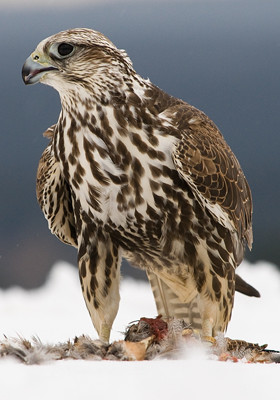Saker Falcon (Falco Cherrug)

| Order: | Falconiformes |
| Family: | Falconidae |
| Subfamily: | Hierofalco |
| Genus: | Falco |
STATUS:
ATTENTION! THIS ANIMAL IS LISTED AS ENDANGERED IN THE REPUBLIC OF UZBEKISTAN! 3(NT): A species, which is close to becoming vulnerable. Listed on the IUCN list as (EN), introduced to CITES appendix II.

In the Republic of Uzbekistan special attention is paid to the protection of birds of prey, listed in the Red Book. It is a criminal act to illegally produce, possess, purchase, transport or smuggle a Saker falcon.
This is a bird of prey from the falcon family. The Saker Falcon is a fairly large falcon, smaller than the merlin, but larger than the Peregrine. Like many other birds of prey, the female Saker falcon about a third larger than males and can weigh up to 1200 grams. The maximum weight of males is less than 900 grams. In comparison with the Merline, the Saker has a more delicate anatomical construction and is of a smaller size.
The Saker rarely nests in Uzbekistan. It is mostly a sedentary bird, preferring to nest in low-mountainous territory. In the winter, the number of these birds increases slightly due to the migration of birds from more northerly areas. The global population of Sakers is low in density.
The bird’s main food sources are small mammals such as gerbils, squirrels, hedgehogs, jerboas and more rarely, birds; blue-grey doves, partridges, stoves, larks; reptiles such as the agama lizard and toads, as well as insects. Sakers hunt both on the ground and in the air, showing a variety of techniques and great versatility.
They nest on cliff ledges, in the niches of clay cliffs and steppe hills, often occupying the old nests of Golden Eagles, Buzzards and vultures, or empty crow’s-nests on power lines. The Saker refills the nest with dry twigs and shoots from shrubs, lining it with animal fur and pieces of dry skin. The female lays 3-5 eggs that are red-brown with dark brown spots in colour and incubates them for a month. The male feeds the female during incubation. Chicks feed on small birds and rodents when they hatch and begin to fly at the age of one and a half months.
Since ancient times the Saker has been considered one of the best birds for falconry. Falconers all over the world appreciate its ability to catch prey, as well as its affectionate nature. It is a very hardy bird that can be hunted in harsh climatic; in hot deserts, open plains, as well as on the plains and in foothill country..
1. Red Book of the Republic of Uzbekistan: II is Animals, Tashkent: Chinor ENK, 2009. 2. Meklenburtsev RN, Sagitov AK Kashkarov DY, Mitropolsky OV ER Fotteler Tretyakov GP, Ostapenko MM Nazarov, AP Birds of Uzbekistan, including Tashkent 1. ‘Fan’ of the Uzbek SSR. 1987.
